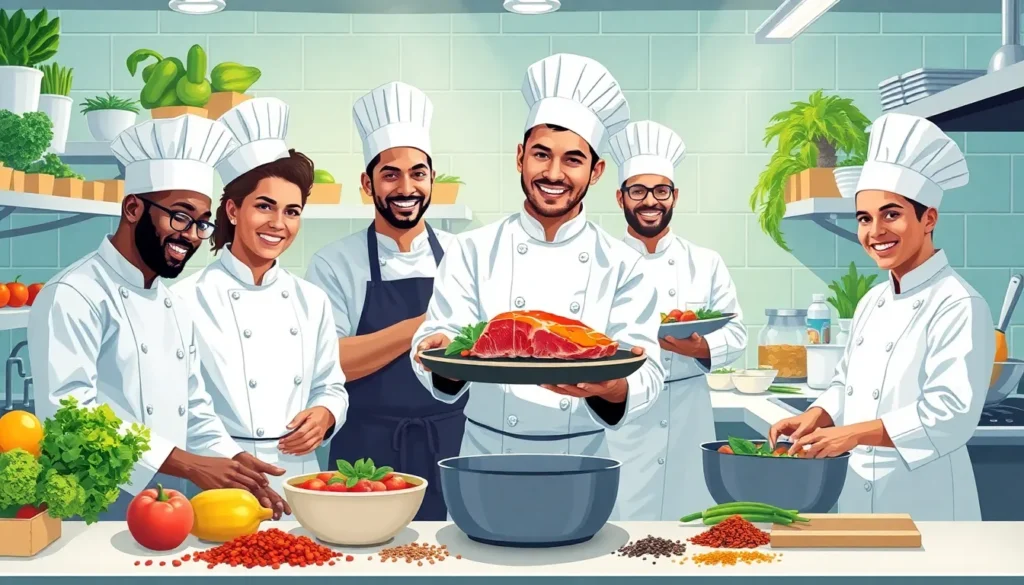In a world where food isn’t just for sustenance but also for social media fame, every meal can be a potential star. Social media food trends are taking over our feeds like an avocado on toast—everyone loves it, and it’s hard to resist snapping a pic before digging in. From the bizarre to the beautiful, these trends not only tantalize taste buds but also ignite creativity in the kitchen.
Table of Contents
ToggleOverview of Social Media Food Trends
Social media food trends dominate online platforms, transforming meals into visual storytelling. Platforms like Instagram and TikTok showcase vibrant dishes, drawing attention through eye-catching images and videos. Creative presentations like rainbow bowls or unicorn lattes capture engagement and inspire home cooks to experiment with their culinary skills.
Dishes characterized by their aesthetic appeal thrive in these environments. Avocado toast, a staple among influencers, exemplifies how simplicity meets visual excellence. Trendy food items frequently spark viral challenges, encouraging users to recreate or put their unique spin on popular recipes.
Navigating these trends, many restaurants adapt their menus to include photogenic options, enhancing customer experiences. Seasonal ingredients often dictate the evolution of these trends, leading to the rise of pumpkin spice everything in the fall or refreshing summer fruit dishes.
User-generated content fuels the excitement surrounding food trends. Hashtags like #FoodTok or #InstaEats create communities where sharing personal culinary creations is encouraged. Local eateries benefit from this visibility, attracting new patrons eager to experience the trending dishes firsthand.
Sustainability also influences current trends, pushing for plant-based options and eco-friendly practices. Consumers increasingly seek establishments that promote local ingredients and environmentally responsible sourcing. This shift encourages a more mindful approach to food consumption, aligning with broader societal values.
Popular Social Media Platforms
Social media platforms significantly shape food trends, allowing users to explore and share culinary creations. Each platform offers unique features that enhance food visibility.
Instagram’s Role in Food Trends
Instagram serves as a visual hub for food enthusiasts. Users post high-quality images of dishes, driving trends like avocado toast and colorful smoothie bowls. Captivating presentation attracts more followers, leading to viral sensations. Restaurants adapt menus with Instagrammable options, increasing customer engagement. Hashtags like #InstaEats improve discoverability, fostering an online community centered around food. Many chefs and home cooks share creative recipes, inspiring others to experiment in their kitchens. Visual storytelling remains key, and influencers amplify trends by showcasing their culinary experiences.
TikTok’s Viral Food Challenges
TikTok thrives on fast-paced, engaging content, making it a breeding ground for viral food challenges. Users often create short videos featuring unique recipes or innovative cooking techniques. Popular challenges encourage participants to remix dishes, such as whipped coffee and feta pasta. These trends frequently prompt food enthusiasts to put their spin on classic recipes. Engagement spikes as users replicate viral videos, showcasing their outcomes with personalized flair. Community involvement boosts visibility, providing additional exposure for food-focused creators. The hashtag #FoodTok captures the essence of this dynamic platform, connecting users through shared culinary exploration.
Emerging Food Trends in 2023
Emerging food trends in 2023 reflect growing preferences shaped by social media dynamics. Trends indicate an increasing focus on health and sustainability.
Plant-Based Diets on Social Media
Plant-based diets gain traction on social platforms, driven by a surge of health-conscious consumers. Creative presentations of vegan dishes dominate feeds, showcasing colorful salads and unique meat alternatives. Influencers champion plant-based recipes, often tagging them with popular hashtags. Instagram and TikTok amplify these efforts, attracting users eager to explore new tastes. Engaging content challenges traditional diets, making plant-based options more desirable. Diverse culinary experiences encourage audiences to adopt plant-centered meals, enhancing nutrition and flavor. Viral recipes featuring ingredients like chickpeas and quinoa inspire home cooks to experiment and share their adaptations.
Sustainable Eating Habits
Sustainable eating habits emerge as a major focus among consumers and creators in 2023. Social media amplifies awareness about local sourcing and seasonal ingredients. Users embrace eco-friendly practices through shared tips and recipes that minimize food waste. Platforms like TikTok highlight meals made from leftovers, inspiring creativity and resourcefulness. Engagement around sustainable food practices cultivates a community prioritizing environmental impact. Restaurants participate by offering plant-based and locally-sourced dishes, appealing to conscious diners. By featuring sustainability-themed content, influencers establish a strong connection between food choices and ethical consumption.
Impact of Social Media on Food Choices
Social media significantly influences food choices, shaping preferences and behaviors across diverse audiences.
The Rise of Food Influencers
Food influencers thrive on platforms where visual appeal reigns. These individuals share unique recipes and innovative food concepts, attracting followers eager to replicate trending dishes. Their content often showcases aesthetically pleasing presentations, making meals irresistible. Influencers like those on Instagram and TikTok not only drive engagement but also set trends that spark creativity in everyday cooking. Many followers trust these influencers for recommendations, which directly impacts their dining choices and home cooking habits. Brands recognize this influence, collaborating with creators to promote new products or menus.
User-Generated Content and Its Effect
User-generated content reshapes how food is perceived and consumed. People share their culinary experiences through posts and videos, contributing to a collective cookbook online. This democratization of content encourages authenticity, where everyday cooks showcase personal twists on popular recipes. Hashtags enable discoverability, connecting users with similar interests and fostering a sense of community. Restaurants gain valuable feedback through user-generated posts, allowing them to adapt menus to meet consumer demands. Simply put, each share has the potential to influence numerous followers, amplifying trends and expanding their reach.
Social media food trends continue to reshape the culinary landscape. With platforms like Instagram and TikTok driving engagement through vibrant visuals and creative challenges, food has transformed into a form of artistic expression. This shift not only inspires home cooks and chefs alike but also encourages a focus on health and sustainability.
As consumers increasingly seek plant-based options and eco-friendly practices, the online food community thrives on sharing innovative recipes and tips. The influence of food creators is undeniable, impacting dining choices and encouraging experimentation in the kitchen. Ultimately, these trends foster a dynamic environment where food becomes a catalyst for connection and creativity.






